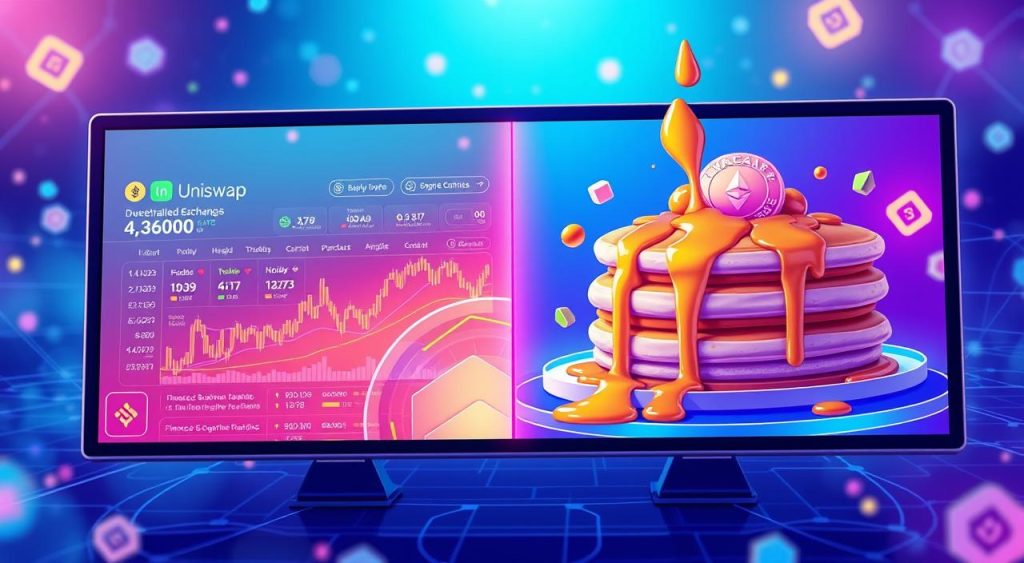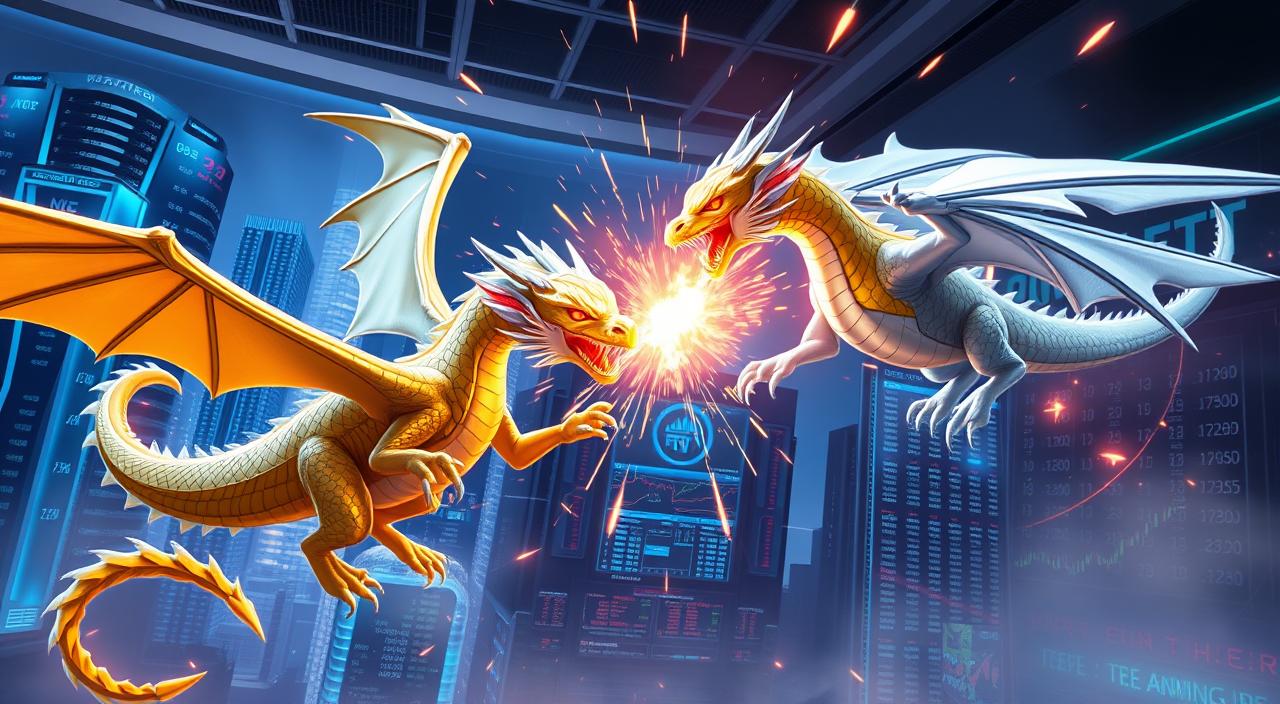🪙 Uniswap vs. PancakeSwap: Which DEX Has the Edge?
In the dynamic world of cryptocurrency trading, the emergence of decentralized exchanges (DEXs) has ushered in a new era of financial empowerment. Two of the prominent players in this space are Uniswap and PancakeSwap, each offering unique features and capabilities. But which one holds the edge? As you navigate the world of DEXs, this article aims to shed light on the key differences between these two leading platforms, guiding you to make an informed decision that aligns with your crypto trading needs.
Key Takeaways
- Uniswap is the #1 decentralized crypto exchange, offering 1,136 cryptocurrencies and 2,039 trading pairs, with a 24-hour trading volume of $1.5 billion and a market share of 14.3%1.
- PancakeSwap is the #3 decentralized exchange on the Binance Smart Chain, providing 435 cryptocurrencies and 1,366 trading pairs, with a 24-hour trading volume of $490 million and a market share of 9%1.
- Uniswap charges a 0.3% fee on each trade, distributed to liquidity providers, while PancakeSwap offers a lower 0.2% fee2.
- PancakeSwap provides additional features like yield farming, staking, and lottery games, catering to a broader range of DeFi enthusiasts2.
- Decentralized exchanges have witnessed a remarkable growth, handling over $600 billion in trade volume between June 2020 and June 20212.
Decentralized Exchanges: Redefining Crypto Trading
Decentralized cryptocurrency exchanges, known as DEXs, are revolutionizing the way we approach digital asset trading. Unlike their centralized counterparts, these platforms enable direct peer-to-peer transactions without the involvement of a central authority3. This decentralized structure empowers users by allowing them to maintain control over their funds and personal information, while also reducing the risk of hacks and security breaches that often plague centralized exchanges.
What are Decentralized Crypto Exchanges?
Decentralized crypto exchanges utilize blockchain technology and smart contracts to facilitate automated trades between users. These platforms, such as Uniswap, SushiSwap, and PancakeSwap, operate on principles of decentralization, allowing traders to transact directly without the need for a central intermediary3. This innovative approach not only enhances user privacy and security but also introduces new trading features like automated market-making (AMM) protocols and liquidity pools.
The Emergence and Evolution of DEXs
The rise of decentralized exchanges has challenged the dominance of traditional centralized exchanges in the cryptocurrency trading landscape3. Platforms like Bancor, which introduced AMMs on Ethereum, have paved the way for the DeFi (Decentralized Finance) era, enabling users to engage in automated trading strategies, liquidity provision, and yield farming3. As the DEX ecosystem continues to evolve, it has attracted significant attention and adoption, with the 1inch platform boasting over 6 million users and collaborating with more than 188 liquidity providers across seven blockchains4.
The integration of DEXs with DeFi protocols has been a game-changer, allowing users to seamlessly access a wide range of decentralized financial services3. Platforms like Curve Finance and Balancer have introduced innovative approaches to liquidity provision and token swapping, offering efficient and cost-effective trading experiences3.
As the DEX ecosystem continues to evolve, it faces challenges such as liquidity concerns for large trades and regulatory uncertainties, while also presenting opportunities for user-friendly interfaces and technological advancements3. Nevertheless, the growth and adoption of DEXs remain on an upward trajectory, driven by the inherent benefits of decentralization, security, and financial autonomy that they offer to cryptocurrency traders3.
| Feature | Centralized Exchanges (CEX) | Decentralized Exchanges (DEX) |
|---|---|---|
| User Control | Centralized control over user funds and personal data | Users maintain full control over their private keys and assets |
| Fees | Higher trading fees | Lower trading fees |
| Transaction Speed | Slower transaction processing | Faster transaction processing |
| Security | Higher risk of hacks and theft | Enhanced security through decentralized architecture |
As the cryptocurrency market continues to evolve, the role of decentralized exchanges in shaping the future of digital asset trading cannot be overstated3. With their emphasis on user autonomy, security, and innovative trading features, DEXs are redefining the landscape of cryptocurrency trading and paving the way for a more decentralized and inclusive financial ecosystem3.
“The rise of decentralized exchanges has challenged the dominance of traditional centralized exchanges in the cryptocurrency trading landscape.”
🔝 Top Decentralized Crypto Exchanges
In the dynamic world of decentralized crypto exchanges, a select few platforms have emerged as the industry’s trailblazers. These top DEXs offer a diverse range of features, liquidity, and trading capabilities, catering to the evolving needs of crypto enthusiasts and investors. Let’s explore some of the leading decentralized exchanges that are redefining the crypto trading landscape.
- Uniswap: As the pioneering Ethereum-based DEX, Uniswap has solidified its position as a market leader. With its innovative automated market maker (AMM) model and extensive cryptocurrency support, Uniswap has become a go-to platform for swapping a wide range of digital assets.
- PancakeSwap: Thriving on the Binance Smart Chain, PancakeSwap has emerged as a formidable competitor to Uniswap. By offering lower transaction fees and faster processing times, PancakeSwap has attracted a growing user base seeking efficient crypto trading solutions.
- Curve Finance: Specializing in stablecoin trading, Curve Finance has carved out a niche for itself in the DEX ecosystem. Its focus on providing deep liquidity and low slippage for stablecoin swaps has made it a preferred platform for traders seeking to minimize volatility.
- dYdX: Catering to the needs of advanced traders, dYdX offers a sophisticated trading platform with features like perpetual contracts, margin trading, and derivatives. Its decentralized architecture and cutting-edge trading tools have made it a popular choice among professional crypto traders.
- Osmosis: Leveraging the Cosmos ecosystem, Osmosis is a decentralized exchange that enables seamless cross-chain trading. Its ability to facilitate transactions between various blockchain networks has positioned it as a hub for inter-chain liquidity.
| DEX | Blockchain | Key Features | Trading Volume (24h) |
|---|---|---|---|
| Uniswap | Ethereum | AMM model, extensive token support | $428 million5 |
| PancakeSwap | BNB Chain | Lower fees, faster transactions | $139.5 million6 |
| Curve Finance | Ethereum | Specialized in stablecoin trading | $133 million5 |
| dYdX | Ethereum | Perpetual contracts, margin trading | $104 million5 |
| Osmosis | Cosmos | Cross-chain trading | $34 million5 |
These top decentralized crypto exchanges continue to evolve, offering innovative features, enhanced user experiences, and diverse trading capabilities to cater to the growing demand for decentralized finance (DeFi) solutions. Whether you’re a novice trader or an experienced investor, exploring these leading DEXs can provide you with a wealth of opportunities to navigate the dynamic crypto landscape.
Uniswap vs. PancakeSwap
As two of the leading decentralized exchanges (DEXs) in the crypto space, Uniswap and PancakeSwap offer distinct features and capabilities that cater to different user preferences and trading needs. While Uniswap has established itself as the pioneering Ethereum-based DEX, PancakeSwap has emerged as a strong contender on the Binance Smart Chain (BSC) ecosystem.
Uniswap: The Pioneering Ethereum-Based DEX
Uniswap has been at the forefront of the decentralized finance (DeFi) revolution, pioneering the use of automated market makers (AMMs) and liquidity pools for token trading7. As of September 2021, Uniswap boasts over $6.3 billion in total value locked (TVL) and has facilitated over $386 billion in trade volume, with more than 1.5 million all-time users7. Uniswap’s open-source nature and commitment to decentralization have made it a popular choice among Ethereum-based DeFi enthusiasts.
PancakeSwap: The Binance Smart Chain Contender
Launched in 2020, PancakeSwap has gained significant traction as a leading DEX on the Binance Smart Chain7. As of September 2021, PancakeSwap claims to have over 2.8 million users and $9.9 billion in TVL7. The platform’s liquidity has increased dramatically, with a surge from $37 million to $1 billion in trading volume within the first 49 days of 20217. PancakeSwap’s native token, CAKE, has also seen substantial growth, gaining over 2,964% since the start of 20217.
One of the key advantages of PancakeSwap is the significantly lower transaction costs on the Binance Smart Chain compared to the Ethereum network7. This has made PancakeSwap an attractive option for users seeking to participate in DeFi activities without the burden of high Ethereum gas fees7.
| Metric | Uniswap | PancakeSwap |
|---|---|---|
| Total Value Locked (TVL) | $6.3 billion7 | $9.9 billion7 |
| Trade Volume | $386 billion7 | $1 billion (within 49 days)7 |
| Native Token Performance | UNI tokens have seen significant growth, but their real use case beyond governance remains unclear7. | CAKE gained over 2,964% since the start of 20217. |
| Transaction Costs | Ethereum gas fees can be high, reaching a peak of 373.8 Gwei on Feb. 23, 20217. | Binance Smart Chain offers transactions in terms of pennies, much lower than Ethereum7. |
| Listed Tokens | 599 tokens as of September 20217 | 1427 tokens as of September 20217 |

While PancakeSwap boasts a larger number of listed tokens, Uniswap still leads in liquidity, with most tokens on Uniswap having substantial liquidity7. Additionally, the quality of listed tokens is an essential factor, as more listed tokens may not necessarily indicate a better quality DEX7.
Ultimately, the choice between Uniswap and PancakeSwap will depend on the user’s preferences, trading needs, and the specific DeFi ecosystem they are operating within. Both platforms offer unique features and advantages, catering to the diverse requirements of the thriving uniswap, pancakeswap, ethereum, binance smart chain, automated market makers, liquidity pools, token trading, and defi ecosystem7.
Key Factors to Consider
When choosing between Uniswap and PancakeSwap, or any other decentralized exchange (DEX), it’s essential to consider several key factors to ensure your trading needs are met. These include liquidity and trading volume, supported cryptocurrencies and trading pairs, as well as the user experience and interface8.
Liquidity and Trading Volume
Liquidity and trading volume are crucial aspects in determining the efficiency and reliability of a DEX. Uniswap charges a flat 0.3% fee on all swaps, with the majority distributed to liquidity providers8. In contrast, PancakeSwap offers a 0.25% fee for swaps, with 0.17% going to liquidity providers8. While Uniswap has suffered security breaches in 2023 that resulted in losses over $25 million8, its V3 update introduced concentrated liquidity and multiple fee tiers for liquidity providers8, potentially improving the platform’s overall liquidity and trading volume.
Supported Cryptocurrencies and Trading Pairs
The variety of supported cryptocurrencies and trading pairs is another essential consideration. Uniswap operates on the Ethereum blockchain, leading to higher transaction fees8, while PancakeSwap operates on the Binance Smart Chain, known for lower transaction costs8. Uniswap supports a larger number of tokens compared to PancakeSwap9, but PancakeSwap has been expanding its token offerings, including popular tokens like BTCB and ETH9.
User Experience and Interface
The user experience and interface of a DEX can significantly impact the overall trading experience. PancakeSwap has a more engaging and visually appealing user interface compared to Uniswap9. Additionally, PancakeSwap offers lower transaction fees than Uniswap due to its use of the Binance Smart Chain9. Consideration of network fees in addition to transaction fees is important when choosing between PancakeSwap and Uniswap9.
| Feature | Uniswap | PancakeSwap |
|---|---|---|
| Liquidity Fees | 0.3% flat fee, majority to liquidity providers | 0.25% fee, 0.17% to liquidity providers |
| Security | Suffered $25 million+ losses due to breaches in 2023 | No major security incidents reported |
| Blockchain | Ethereum, higher transaction fees | Binance Smart Chain, lower transaction fees |
| Supported Tokens | Larger number of tokens | Expanding token offerings, including BTCB and ETH |
| User Interface | Less visually appealing | More engaging and user-friendly |
In summary, when choosing between Uniswap and PancakeSwap, or any other DEX, it’s crucial to carefully evaluate the platform’s liquidity, trading volume, supported cryptocurrencies, trading pairs, user experience, and interface to ensure it aligns with your trading needs and preferences8910.
Pros and Cons of Uniswap and PancakeSwap
As two of the prominent decentralized exchanges (DEXs) in the crypto space, Uniswap and PancakeSwap each offer a unique set of advantages and potential drawbacks for users to consider. Understanding the pros and cons of these leading DEXs can help traders make informed decisions about their cryptocurrency trading strategies.
One of Uniswap’s key strengths is its significant market dominance, with a market cap of $5.6 billion as of June 2024, significantly higher than SushiSwap’s $222 million and PancakeSwap’s $573 million11. Additionally, Uniswap has maintained a leadership position in the growing DeFi ecosystem, with its Total Value Locked (TVL) increasing from $15 billion to over $19 billion in the last 12 months11. Uniswap’s monthly trading volume has consistently led the pack, reaching nearly $122 billion in March 2024, surpassing the volume from May 202211. Furthermore, Uniswap’s token, $UNI, has shown the best price performance, doubling in value over the last 12 months compared to SushiSwap’s $SUSHI and PancakeSwap’s $CAKE11.
On the other hand, PancakeSwap offers a distinct advantage in terms of lower transaction fees, as it operates on the Binance Smart Chain (BSC) rather than the Ethereum blockchain like Uniswap12. This cost-effective trading experience on PancakeSwap can be particularly appealing to traders who are mindful of gas fees12. Additionally, PancakeSwap provides users with opportunities to earn rewards through its Syrup Pools, where they can stake CAKE tokens to receive additional tokens12.
Both Uniswap and PancakeSwap offer user-friendly interfaces and have undergone security audits to ensure the safety of user funds, although audits do not eliminate all potential risks12. Uniswap, with its longer history and established presence in the DEX market, boasts a wider range of supported tokens and higher trading volume compared to PancakeSwap12.
In summary, the choice between Uniswap and PancakeSwap ultimately depends on the individual trader’s priorities, such as market dominance, trading volume, token availability, transaction fees, and yield farming opportunities. Understanding the unique features and trade-offs of these leading DEXs can help traders make informed decisions that align with their investment strategies and preferences.

Conclusion
In the dynamic world of crypto trading, decentralized exchanges (DEXs) have emerged as a game-changing alternative to traditional centralized platforms. Uniswap and PancakeSwap, two of the most prominent DEXs, offer distinct features and capabilities that cater to different user preferences and trading needs13.
While Uniswap leads in terms of trading volume and developer activity, PancakeSwap stands out for its lower trading fees and faster transactions on the Binance Smart Chain1314. PancakeSwap’s CAKE token also provides unique benefits like weighted voting and boosted farm yields, making it an attractive option for yield farmers and BSC token enthusiasts15.
Ultimately, the choice between Uniswap and PancakeSwap depends on your specific dex selection needs and preferences. Whether you prioritize trading volume, token selection, or cost-effective transactions, both platforms offer compelling solutions for decentralized crypto trading. By understanding the strengths and weaknesses of each DEX, you can make an informed decision that best aligns with your crypto trading goals131514.








Post Comment